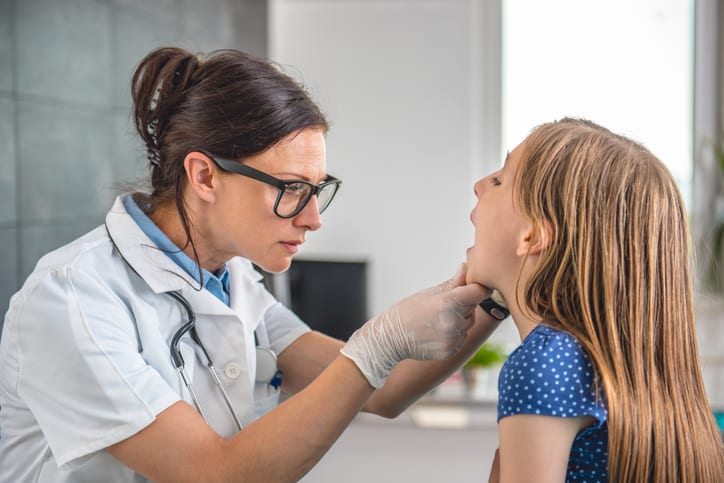Parents are familiar with this scenario.
Your child wakes up in the morning complaining his throat is itchy and dry. It’s a sore throat. Actually, Mommy and Abba are convinced it is strep throat. They phone the pediatrician’s office, asking for an appointment. An immediate appointment. They want instant information. And medication to assassinate those germs. Further, Mommy and Abba also need to know that if Shlomo is staying home sick, one of them has to rearrange their work schedule.
Are all sore throats strep throats? Do sore throats require immediate attention?
Fact: Most sore throats are not strep throats.
A sore throat is pain, scratchiness or irritation of the throat that often worsens when you swallow. The most common cause of a sore throat (pharyngitis) is a viral infection, such as a cold or the flu. A sore throat caused by a virus resolves on its own.
The typical symptoms of a pharyngitis or tonsillitis may include:
- Pain or a scratchy sensation in the throat
- Pain that worsens with swallowing or talking
- Difficulty swallowing
- Sore, swollen glands in your neck or jaw
- Swollen, red tonsils
- White patches or pus on your tonsils
- Hoarse or muffled voice
Common infections and viruses that cause a sore throat might result in other signs and symptoms, including fever, cough, runny nose, sneezing, body aches, headache, nausea or vomiting.
Strep throat differs in that it is an infection in the throat and tonsils caused by bacteria called Group A Streptococcus (group A strep). This bacteria lives in the nose and throat and can spread easily to other people. Not all infected people have symptoms or seem sick. People who are infected spread the bacteria by coughing or sneezing, which creates small respiratory droplets that contain the bacteria. People can get sick if they breathe in those droplets, touch something with droplets on it and then touch their mouth or nose, drink from the same glass or eat from the same plate as a sick person, and/touch sores on the skin caused by group A strep (impetigo).
Believe it or not, toothbrushes can be guilty of spreading Group A Streptococcus. Yes, those sticks with bristles at one end on which you put toothpaste and then insert into your mouth and brush your teeth can spread germs. They tend to stay wet for a while after use which then spreads germs. Also, many households place the toothbrushes together and therein lies yet another way via which those nasty germs spread. My suggestion: change toothbrushes after starting medication.
It is very rare to spread group A strep through food that is not handled properly. Experts do not believe that pets or household items like toys spread these bacteria.
Strep throat is more common in children than adults. It is most common in children 5 through 15 years old. It is rare in children younger than 3 years old. Up to 3 in 10 children who have a sore throat have strep throat.
About 1 in 10 adults with a sore throat have strep throat. Adults who are at risk for strep throat include parents of school age children and adults who are often in close proximity to children.
Let’s go back to our opening scenario of Shlomo waking up with a sore throat. When is it time to call the pediatrician?
According to the American Academy of Pediatrics, call if the throat soreness does not go away with the first drink (preferably water) of the morning. Seek immediate help if your child has difficulty breathing and swallowing and/or has an unusual amount of drooling.
How is strep throat diagnosed?
In addition to a physical exam during which the doctor examines the throat eyes and ears and feels the lymph nodes, there is a simple test that gives fast results called the rapid strep test. This entails swabbing the throat and running a test on the swab. The test quickly shows if group A strep is causing the illness. If the test is positive, doctors can prescribe antibiotics. If the test is negative, but a doctor still suspects strep throat, then the doctor can take a throat culture swab. A throat culture takes time to see if group A strep bacteria grow from the swab. While it takes more time, a throat culture sometimes finds infections that the rapid strep test misses.
A culture is an important step to use in children and teens since if strep throat is not detected, your loved ones can get rheumatic fever, a heart disease where the heart is attacked by antibodies that are made to kill strep but cross-react with the heart, from an untreated strep throat infection. For adults, it is usually not necessary to do a throat culture following a negative rapid strep test. Adults have a lower risk of getting rheumatic fever following an untreated strep throat infection.
Strep can also cause other diseases, i.e., glomerulonephritis (kidneys), skin infections and even bone infections. PANDAS (Pediatric Autoimmune Neuropsychiatric Disorders Associated with Streptococcal Infections) will be a separate discussion.
Doctors treat strep throat with antibiotics. Penicillin derivatives are recommended as a first choice for people who are not allergic to penicillin. Doctors can use other antibiotics to treat strep throat in people who are allergic to penicillin. Someone with strep throat should start feeling better within a day or two after starting antibiotics. Antibiotics decrease the length of time one feels sick, decreases symptoms, prevents bacteria from spreading to others and previous more serious complications i.e., rheumatic fever.
Interestingly, people can get strep throat more than once. Having strep throat once does not protect one from contracting it again in the future. There is no vaccine to prevent strep throat. However, there are things that people can do to protect themselves and others from it.
Good hygiene helps prevent group A strep infections. Things to keep in mind include:
- Wash your hands. This is especially important after coughing or sneezing and before preparing foods and eating.
- Cover your mouth and nose with a tissue when coughing or sneezing. Dispose of the used tissue in the waste basket.
- Cough or sneeze into your elbow or sleeve if you do not have a tissue.
- Wash your hands often with soap and water for at least 20 seconds.
- Change the toothbrushes. Throw out the toothbrush of the sick child. If the family toothbrushes are stored together, throw them all out and start new toothbrushes.
People with strep throat should stay home from work, school, or daycare until they no longer have fever AND have taken antibiotics for at least 24 hours.
Take the prescription exactly as the doctor says to. Don’t stop taking the medicine before the course is completed.
Please note again that only 3 in 10 children with a sore throat have strep throat. In other words, most sore throats are not strep throats. This means you don’t have to run to the doctor just because Rachelli’s throat is sore. Take a deep breath. If your child has a sore throat, have them drink water. Most of the time, the sore throat resolves itself. If not, your pediatrician is there for you.
As always, daven.
Dr. Hylton I. Lightman is a senior statesman among pediatricians, an internationally-recognized authority and diagnostician, a public speaker, expert witness and go-to resource for health issues in the Orthodox Jewish community and beyond. Originally from South Africa, he started his current practice, Total Family Care of the Five Towns and Far Rockaway, PC in 1987. Dr. Lightman is a board-certified pediatrician and fellow of the American Academy of Pediatrics (FAAP). Dr. Lightman is a clinical assistant professor of pediatrics at Hofstra Northwell School of Medicine. In addition, he is actively involved in teaching pediatric and family nurse practitioners through Columbia University, Pace University, Lehmann College, and Molloy College, as well as mentoring physician assistants through Touro College. Read more here.
The words of this author reflect his/her own opinions and do not necessarily represent the official position of the Orthodox Union.

